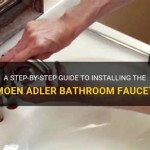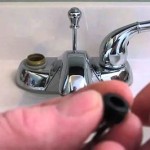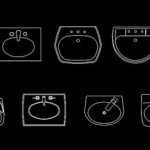How to Remove Fingernail Polish From a Bathroom Sink
Accidental spills are a common occurrence in the bathroom, and fingernail polish is a frequent culprit. Its vibrant color and quick-drying nature, while desirable on nails, can present a challenge when splattered on a bathroom sink. The key to successful removal lies in prompt action and the appropriate choice of cleaning agents and techniques, taking into careful consideration the sink material to avoid causing damage.
The composition of fingernail polish contributes to its persistence on surfaces. It typically contains film-forming polymers, solvents, pigments, and plasticizers. The solvents, such as ethyl acetate and butyl acetate, evaporate quickly, leaving behind a hardened film of colorant adhered to the sink. This hardened film is resistant to water and ordinary soap, necessitating the use of stronger solvents or abrasive methods to dislodge it.
Before embarking on any cleaning process, safety precautions are paramount. Adequate ventilation is essential when working with solvents, and the use of gloves is recommended to protect the skin from irritation. Eye protection should also be considered to prevent accidental splashes. Furthermore, testing any cleaning solution on an inconspicuous area of the sink is crucial to ensure it does not discolor, etch, or otherwise damage the surface.
Different sink materials react differently to cleaning agents. Porcelain, a common material, is generally durable but can be susceptible to scratching from abrasive cleaners. Acrylic sinks are more prone to scratching and chemical damage, requiring the use of gentler solutions. Stone sinks, such as granite or marble, are porous and can absorb stains, making prompt and careful cleaning even more crucial. Therefore, identifying the sink material is the first step towards choosing the appropriate removal method.
Using Non-Acetone Nail Polish Remover
Non-acetone nail polish remover, while less potent than its acetone counterpart, can be effective on fresh spills and is generally safer for delicate sink materials. It contains solvents like ethyl acetate or isopropyl alcohol, which can soften the hardened polish without posing the same risk of damage as acetone.
The process begins by blotting the spilled polish with a clean cloth or paper towel to absorb as much of the liquid as possible. Avoid rubbing, as this can spread the stain and embed it further into the sink surface. Next, saturate a cotton ball or pad with non-acetone nail polish remover and gently dab it onto the stain. Allow the remover to sit for a few minutes to soften the polish.
After the soaking period, use a soft cloth or sponge to gently rub the stain in a circular motion. Avoid applying excessive pressure, which could scratch the sink. Continue dabbing with the non-acetone remover and rubbing with the cloth until the polish begins to lift. It may be necessary to repeat this process several times to completely remove the stain, especially if it has already dried.
Once the polish is removed, thoroughly rinse the sink with warm water to remove any residue from the nail polish remover. Dry the area with a clean cloth to prevent water spots. Inspect the area closely to ensure that no traces of the stain remain. If necessary, repeat the process or try a different method.
For stubborn stains, a variation of this method involves creating a paste of baking soda and non-acetone nail polish remover. The baking soda acts as a gentle abrasive, helping to lift the stain. Apply the paste to the stain, let it sit for a few minutes, and then gently scrub with a soft cloth. Rinse thoroughly with water and dry.
Employing Rubbing Alcohol (Isopropyl Alcohol)
Rubbing alcohol, also known as isopropyl alcohol, is another solvent that can be effective in removing fingernail polish from bathroom sinks. It is generally considered safe for most sink materials, but it should still be tested on an inconspicuous area first. Rubbing alcohol works by dissolving the polymers in the nail polish, weakening its grip on the sink surface.
Similar to the non-acetone remover method, the first step is to blot up any excess polish with a clean cloth. Then, saturate a cotton ball or pad with rubbing alcohol and apply it to the stain. Allow the alcohol to sit for several minutes to penetrate the polish. For particularly stubborn stains, a cotton ball soaked in rubbing alcohol can be taped to the stain and left to sit for a longer period, such as 30 minutes to an hour.
After the soaking period, gently rub the stain with a soft cloth or sponge. The polish should begin to soften and lift from the sink surface. If necessary, reapply rubbing alcohol and continue rubbing until the stain is completely removed. Avoid using abrasive scrubbers, as they can scratch the sink.
Once the stain is removed, rinse the sink thoroughly with warm water to remove any residue of rubbing alcohol and dissolved polish. Dry the area with a clean cloth. If any traces of the stain remain, the process can be repeated, or a different cleaning method can be attempted.
A variation of this method involves using a combination of rubbing alcohol and a mild dish soap. Mix a few drops of dish soap with rubbing alcohol and apply the solution to the stain. The soap can help to emulsify the dissolved polish, making it easier to remove from the sink surface. After applying the solution, gently scrub the stain with a soft cloth, rinse with water, and dry.
Utilizing Acetone (With Caution)
Acetone is a powerful solvent and is highly effective at dissolving fingernail polish. However, it should be used with extreme caution, as it can damage certain sink materials, particularly acrylic and some plastics. It is crucial to test acetone on an inconspicuous area of the sink before applying it to the stain. Acetone should only be considered as a last resort when other methods have failed.
Before using acetone, ensure that the area is well-ventilated. Wear gloves and eye protection to protect skin and eyes. Blot up any excess polish with a clean cloth. Saturate a cotton ball or pad with acetone and gently dab it onto the stain. Avoid rubbing, as this can spread the stain and potentially damage the sink surface.
Allow the acetone to sit on the stain for a very short period, typically no more than a minute or two. It is crucial to monitor the surface closely for any signs of damage, such as discoloration or etching. If any damage is observed, immediately stop using acetone and rinse the area thoroughly with water.
After the brief soaking period, gently rub the stain with a soft cloth or sponge. The polish should dissolve quickly. If the polish is particularly stubborn, reapply acetone sparingly and continue rubbing gently. Avoid applying excessive pressure or using abrasive scrubbers. Once the stain is removed, immediately rinse the sink thoroughly with warm water to remove all traces of acetone. Dry the area with a clean cloth.
To minimize the risk of damage when using acetone, consider applying it with a cotton swab rather than a cotton ball or pad. This allows for more precise application and reduces the chance of the acetone coming into contact with surrounding areas of the sink. After applying the acetone with a cotton swab, immediately wipe the area with a damp cloth to remove any residue.
In the event of accidental staining, prompt action is essential. The longer the nail polish remains on the sink surface, the more difficult it will be to remove. While these methods offer effective solutions, prevention remains the optimal approach. Exercising caution when applying nail polish near the sink and using a protective barrier can significantly reduce the likelihood of accidental spills and stains.

How To Remove Nail Polish Off Porcelain Tiles Alpine Carpet Cleaning

How To Get Nail Polish Stains Out Of Anything

How To Get Fingernail Polish Out Of A Bathroom Sink Hunker

Nail Polish On Sink Hometalk

How To Get Nail Polish Off Your Bathroom Sink

How To Remove Nail Polish From Bathroom Sink Get Long Nails

How To Thin Out Nail Polish That S Thick And Clumpy 3 Methods
How To Remove Nail Polish Remover Stains From Marble Vanity Quora
:max_bytes(150000):strip_icc()/GUEST_480fa1b7-65f6-411b-b13e-d8de224cce77-b79ddb0a5c5042459d2929f70e83d364.jpeg?strip=all)
How To Remove Nail Polish 6 Easy Methods

How To Remove Dried Nail Polish Splashed On Wall Tile Floor Hometalk
Related Posts







